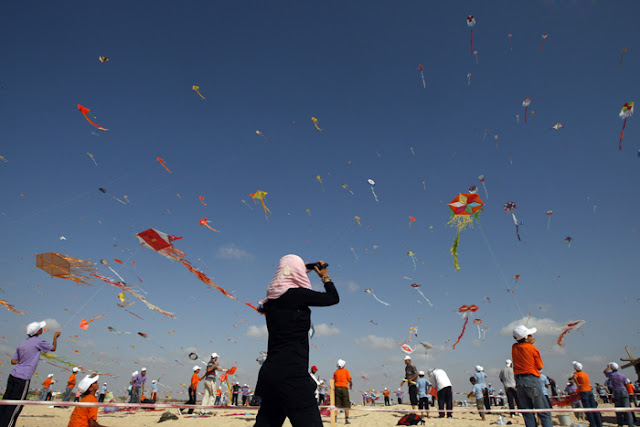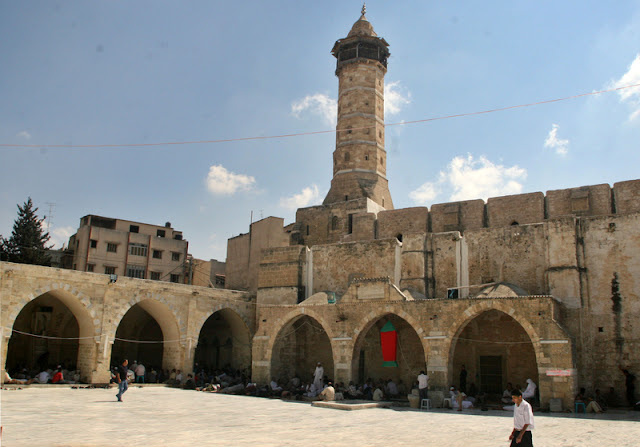Although today’s reality is very different, the following is an example of how we would eventually like to introduce the region to visitors:
 |
| Children flying kites on Gaza beach |
Stretching along the sea, Gaza is famous for its beautiful beaches and fishing culture, which in turn contributes to its unique cuisine. Gazan food is known throughout the region for its generous use of spices and chillies. Many of the traditional dishes, whether based on meat, vegetables or seafood, rely on clay-pot cooking.
Situated at the crossroads between Africa and Asia, the fertile lands of Gaza in southwest Palestine have been of geo-strategic importance since the Neolithic period. Gaza once constituted the hub of ancient trade routes, connecting Egypt with Canaan, Syria, and Mesopotamia and its port linked the entire region with the rest of the Mediterranean.
Throughout its long history Gaza has witnessed numerous battles of conquerors and invaders and subsequently formed part of many great empires, all of which have left their traces in the region. As such, Gaza is full of interesting archaeological and historic sites, including the remnants of Napoleon’s fort, Byzantine ruins and tombs, and Mamluk era structures to name just a few.
Come on a tour to Gaza and witness everyday life in the region’s urban centres of Gaza City, Rafah or Khan Younis, and take a walk through the buzzing local markets, where merchants offer everything from local handicrafts to spices and fish…
 |
| The Great Omari Mosque in Gaza City |
During the 1990s, in the aftermath of the Oslo agreements, Gaza became a tourist destination of choice for thousands of Palestinian citizens of Israel. However following the Hamas takeover of Gaza in June 2007, Israel imposed a blockade which has turned the second most densely populated region in the world into an open-air prison. According to the UN, the siege constitutes a denial of basic human rights, is a clear contravention of international law and amounts to collective punishment.
In June of 2012 the UN published the following statistics:
• 35% of Gaza’s farmland and 85% of its fishing waters are totally or partially inaccessible due to Israeli imposed restrictions.
• 34% of Gaza’s workforce, including over half of its youth is unemployed.
• 44% of Gazans are food insecure and about 80% are aid recipients.
• A severe fuel and electricity shortage results in outages of up to 12 hours a day.
• Over 90% of the water from Gaza aquifer is unsafe for human consumption without treatment.
• Some 71,000 new housing units are required to cover housing needs.
• Since the intensification of the blockade in 2007, nearly 2,300 Palestinians have been killed and 7,700 injured by Israeli forces, about two thirds of them during Operation “Cast Lead” in 2008/2009. Over a quarter (27%) of all Palestinian fatalities were women and children.
• During the same time 37 Israelis have been killed and 380 injured in attacks launched from Gaza, 40% of whom were civilians.
Since last week the already desperate situation in Gaza has deteriorated considerably. At the time of writing, there are 114 Palestinian fatalities and more than 920 casualties, compared to 3 Israeli fatalities and dozens of casualties.
Obviously, human beings are more than numbers and neither Palestinians nor Israelis have a monopoly on suffering, pain and loss. And yet, the disparity of the casualties and injuries stresses the need to contextualise the exchange of fire between Gazan combatants and the Israeli army within the larger scheme of Israel’s occupation and siege on the region, as well as its superior military resources.
While we acknowledge and share the anxiety and suffering of Israeli citizens, especially those living in the South, we maintain that the government’s use of disproportionate force cannot pacify the situation in Israel’s South, but instead only fuels the cycle of violence, which in turn will further endanger the well-being of people on both sides.
While condemning the killing of civilians on both sides, we insist that it is Israel’s responsibility to relieve the population of Gaza by ending the blockade and eventually the occupation. For the sake of both Palestinians and Israeli Jews, we demand an end to all forms of violence, including the structural violence of discriminatory policies towards the Palestinian population as a whole.




Comment (0)